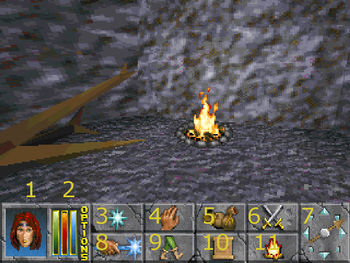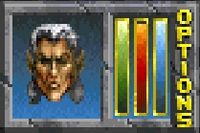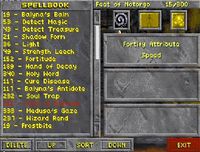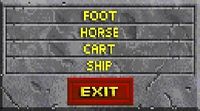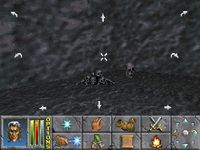Daggerfall:User Interface
Contents
This page covers Daggerfall's User Interface and its components. The User Interface is customizable; the default key commands can be bound to almost any key of your choice. In addition, there are two control schemes involving the mouse. The default controls are similar to Arena's, though the game manual recommends using the alternate controls. Both these schemes are described below.
User Interface[edit]
Game Screen[edit]
By default, each new game begins with the UI visible. You can toggle full-screen view from the Options menu. This hides everything save the status bars and compass, but all the hidden features are still accessible via hotkeys.
Each portion of the lower part of the screen has a function. Aside from the status bars and compass, clicking on these will toggle various features, as detailed below. These features are also accessible via hotkey at all times.
Legend[edit]
- Character Portrait. Click to view your character sheet (F5 key)
- Status Bars and Options Menu (ESC key)
- Spellbook (Backspace key)
- Interaction mode select (see below)
- Inventory (F6 key)
- Combat Toggle (A key)
- Compass. Click to see current date and location (I key)
- Magical Items Menu (U key)
- Transportation options menu (T key)
- Map. Left click for Automap, right click for Travel Map (W and M keys)
- Rest (R key)
Status Bars and Compass[edit]
The Status Bars and Compass are arguably the most important parts of the User Interface, as they appear onscreen even in full screen view.
Status Bars[edit]
Health[edit]
Health is a measure of how injured you are, with full health representing a lack of any current injuries. Your health is given in hit points, and represented on the game screen as a green bar. If your hit points fall to zero, you die, and your game is over (with one notable exception).
Fatigue[edit]
Fatigue is a measure of how refreshed and alert you are, represented by the red status bar. Almost any action you take causes the bar to drop. If it reaches zero, you collapse from exhaustion and awaken one hour later, slightly refreshed. However, if this happens when enemies are around, they will kill you before you wake up.
Your maximum fatigue is equal to the sum of your Strength and Endurance attributes.
Magicka[edit]
Magicka is your potential spellcasting ability. This is represented by the blue status bar, and measured in spell points. Every spell has an associated magicka cost, and your current spell point total must exceed that cost to cast it. Once cast, your magicka is drained by this amount. Aside from the inability to cast spells, there is no penalty if your magicka falls to zero.
Options[edit]
Clicking this word opens the Options menu, where you can save and load games, toggle full screen and head bobbing, customize the key controls, or exit the game.
Compass[edit]
The compass acts as a traditional compass, showing what direction you are currently heading in. In full screen view, this takes a more compact form.
Clicking on the compass with the UI visible brings up information on your current location, the time of day, and the date. Time is shown by a 24-hour clock; 1:00 P.M. is 13:00. This will also display any diseases you currently suffer from (or the lack thereof).
Spellbook[edit]
Click the Sunburst icon to access your spellbook. This is only available if you have a spellbook in your inventory and know at least one spell.
Interaction Mode[edit]
Whenever you click an object, NPC, or enemy, the currently selected Interaction Mode determines the effect of that interaction. There are four modes:
- Steal mode: picking finger icon (F1 key)
- Grab mode: grabbing hand icon (F2 key)
- Info mode: eye icon (F3 key)
- Dialogue mode: word balloon icon (F4 key)
| Object Clicked | Mode | Result |
|---|---|---|
| Person | Steal | Pickpocket a viable town NPC or an enemy |
| Grab or Dialogue | Speak to an NPC (when possible) | |
| Info | Displays an NPCs name or enemy's type | |
| Door | Steal | Attempt to pick a locked door |
| Grab | Open an unlocked door | |
| Info or Dialogue | Check if a door is locked | |
| Treasure, dead body, etc. | Grab or Dialogue | Allows you to loot the item |
| Info | Describes the object | |
| Buildings | Any | Gives name or description of the building |
Character Sheet[edit]
The character sheet displays your character's stats, skills, affiliations, and other vital information. You can access the character sheet from the main screen by clicking on your character portrait or pressing the F5 key.
Below your stats are four buttons. "Inventory", "Spellbook", and "Log" open these respective menus, as on the main screen. Clicking "History" allows you to view the backstory generated for your character.
Transportation[edit]
If you are outdoors, clicking on the Legs icon (or pressing the T key) will display your available transportation options. These are foot, horse, cart, and ship.
Travel by foot is also known as "walking", and is the only option available upon starting a new game. You can also run by holding the Run key and moving. Walking will slowly drain your Fatigue Bar, running will do so more quickly. If you wish to go indoors, you must first be traveling by foot.
Travel by horse is faster than all but the greatest runners. Your fatigue loss will be minimal if riding a horse.
Travel by cart is slightly slower than by horse, but still faster than walking. In addition, you can store items in the wagon.
If you own a ship, selecting "Ship" will instantly transport you to your vessel. While aboard, the other travel options are unavailable; selecting "Ship" again will transport you back to your original location.
For more information on finding your way around Tamriel, see this page.
Maps[edit]
Left-clicking on this brings up your current Automap. Right-clicking on this brings up your Travel Map.
For more information on maps, see here.
Resting[edit]
To open the Rest Menu, click the Campfire icon or press the "R" key. The menu gives three options:
- Rest for a number of hours of your choice (up to 99)
- Rest until fully healed
- Loiter (wait around) for up to 3 hours
Resting restores lost health, fatigue, and magicka, while loitering does not. However, resting within a town is considered vagrancy. This is a crime, and the town guards will attempt to arrest you for it; loitering will not get you in legal trouble. Take care where you rest as well, doing so in a dangerous area may attract wandering enemies that will interrupt your rest (and attack you).
The Rest Menu will be unavailable if there are enemies in the immediate vicinity.
Mouse Controls[edit]
To switch between these schemes, select Mouse in the Controls menu and click on your preferred setup.
Cursor Based Interface (default)[edit]
When the cursor is in the game-world section of the screen, it appears as either an arrow or an X.
Hold the left mouse button while the cursor is an arrow to move in that direction. The closer the arrow is to the edge of the screen, the faster you move. Your top movement speed is a factor of your Speed attribute and your Running skill.
If you left click while the cursor is an X, you will interact with the object or NPC the cursor is currently pointing at. The resulting action depends on what Interaction Mode you are currently in.
If you aren't currently wielding a weapon, right clicking will also interact with objects regardless of what the cursor is at that moment. If your weapon is readied, however, right clicking will execute an attack. Pressing the shift key while right clicking will allow you to interact with objects even if your weapon is out.
Hold the ALT key and move the mouse to look around. Note that when you release the ALT key, your viewing angle will lock in that direction. This allows you to look to either side while moving straight ahead. Left clicking or pressing the HOME key will re-center your view.
View Based Interface[edit]
The view based interface is similar to more recent first-person games. Moving is accomplished with the arrow keys while you use the mouse to adjust your view. You will move at a constant speed unless running or sneaking.
Press the Activate Center Object button (by default, the spacebar) to interact with NPCs or objects centered in your view. As above, the resulting action depends on what Interaction Mode you are currently in.
To bring up the cursor, press the ENTER key. This will freeze your view and allow you aim spells, and interact with the icons at the bottom of the screen (if you aren't in Full Screen mode).
See here for a few recommended changes to the default keys when using this control scheme.
